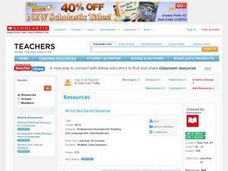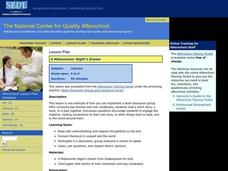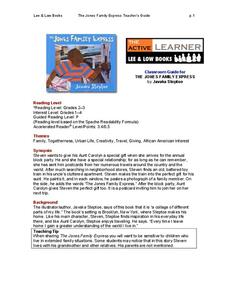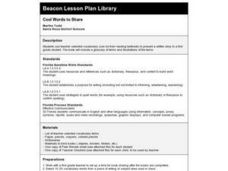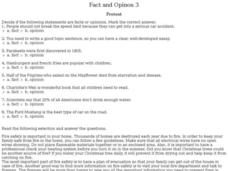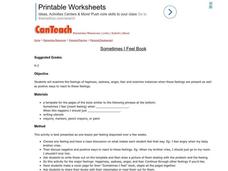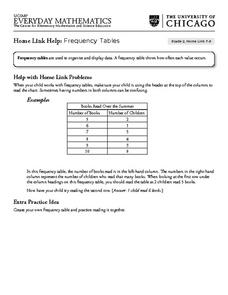Curated OER
What Can We Do Today?
Learners practice rereading selected passages to improve their reading fluency. Working in pairs, students read and reread decodable, leveled passages fluently and with expression. They are assessed by their partner, using a fluency...
Curated OER
Icky Fingers
Students are introduced to digraphs so they can match letters to their phonemes. They recognize the short vowel i=/i/ in both spoken and written words by practicing reading and spelling words containing /i/. Elkonin Letter Boxes are...
Curated OER
Traveling With Limited Funds; A Tree Grows in Brooklyn
Students participate in a pre-reading activity which helps them see what it would be like to live in poverty. In this reading comprehension lesson, students make a list of items they take on a trip considering they have very limited...
Curated OER
Giving a Voice to Literature
Young scholars explore podcast design. In this literacy and technology instructional activity, students read a novel during book club and design a promotional podcast to recommend the book to their peers. Necessary technology...
Curated OER
Close Your Eyes and Imagine...
Young scholars practice the techniques and strategies to become more fluent readers through visualization. They read and construct mental images from the reading of a text. The book, "Charlotte's Web," by E.B. White is read in class and...
Curated OER
Basic Word Problems
In this basic word problems worksheet, 6th graders solve 5 different types of word problems based on information described in each problem. First, they determine the number of books needed to read. Then, students determine the total...
Curated OER
Cause and Effect with "Cloudy With a Chance of Meatballs"
Fourth graders explore reasoning by reading a book with their classmates. For this cause and effect lesson, 4th graders read the children's story Cloudy with a Chance of Meatballs and discuss the story elements, characters and plot....
Curated OER
Write Like David Shannon
Students listen to several of David Shannon's books and identify patterns in the text. They write and illustrate a story of their own in the style of David Shannon, and share their books with classmates.
Curated OER
Oral Language
Students explore rhyming words. In this rhyming lesson, students discuss rhyming words, brainstorm words that end with 'at,' read poems with rhyming words and create their own rhyming books.
Curated OER
Activity Plan 3-4: Let's Find Signs!
Students develop early reading skills as they explore signs and their meanings. In this early childhood lesson plan, students identify various signs and their meanings. Students use laminated signs as manipulatives in matching and...
Curated OER
A Midsummer Night's Dream
Students explore the book A Midsummer Night's Dream. For this literature lesson, students identify main characters and vocabulary words from the text. Students participate in a book discussion group.
Curated OER
The Jones Family Express
Students complete pre reading, writing, during reading, and interdisciplinary activities for the book The Jones Family Express. In this reading lesson plan, students complete journal entries, answer short answer questions, have...
Curated OER
Cool Words to Share
Fifth graders use teacher-selected vocabulary to present a written story to a first grade student. The book include a glossary of terms and illustrations of the terms. This is a great lesson plan for big/little buddies to do together!
Curated OER
Blending with Frog and Toad
Students apply word analysis and vocabulary skills to comprehend selections by reading and interpreting a variety of literary words. They then make predictions about the story and identify blends within the English language.
Curated OER
Flavorful Friends
Students read a book about friends, talk about good friends, and make "flavorful friends" out of food. In this friends lesson plan, students make their "friends" out of cookies, raisins, m&m's, and more.
Curated OER
Fact and Opinion 3: Pretest
In this fact and opinion worksheet, learners answer multiple choice questions where they identify fact and opinion sentences and answer fact and opinion questions about a passage they read. Students complete 10 questions total.
Read Works
Protagonist
Teach your class how to identify the protagonist in a story. The plan suggests starting with a protagonist from a tale you have previously read in class. Then, you can read a new story and work together to identify the protagonist,...
Curated OER
John Singleton Copley's art
Pupils illustrate a story after researching John Singleton Copley's paintings. In this John Singleton Copley lesson plan, students read the background of some of his paintings and then illustrate their own story and create a flip book...
Curated OER
Start Book
Students review their notes, drawings, photos and writing from the field trip to share with the whole group. They make a fiction or nonfiction storybook as a group. They include writing from all students and can include artwork and...
Curated OER
Personal Pronouns: Putting It All Together
For this personal pronouns worksheet, students fill in 10 fill in the blank answers about personal pronouns and choose which multiple choice pronoun in parentheses correctly completes 8 sentences. Students practice using the pronouns I...
Curated OER
Sometimes I Feel Book
Students examine the feelings of happiness, sadness, anger, fear and examine instances when these feelings are present as well as positive ways to react to these feelings.
Curated OER
Who's Your Favorite Author?
Imagine a kindergarten author study. Did you know that Angela Johnson writes about families while Eric Carle writes about insects and animals? In small groups, the class examines a basket of books sorted by author and records...
Curated OER
Literary Skills
Develop their literary skills. In this literature lesson plan, students collaborate to read portions of books and examine settings, plots, main ideas, and conclusions.
Curated OER
Frequency Tables - Home Link Support
In this home school support worksheet, 2nd graders, with a home support person, review the use of frequency tables to organize and display data. They make their own frequency table and read it with the support person.







